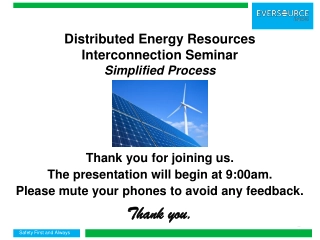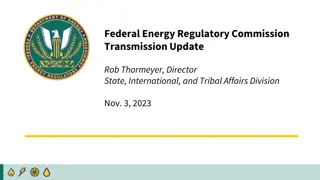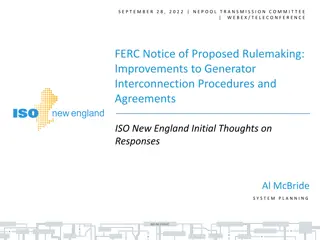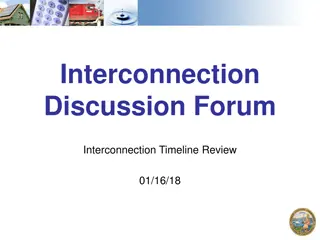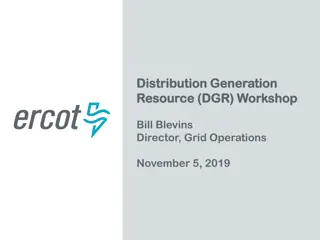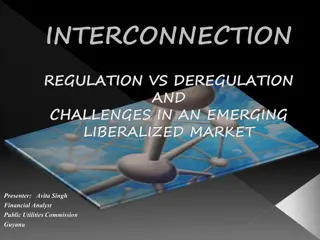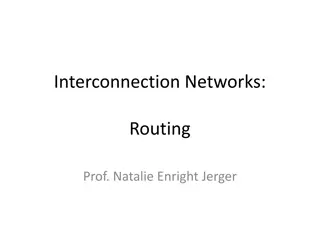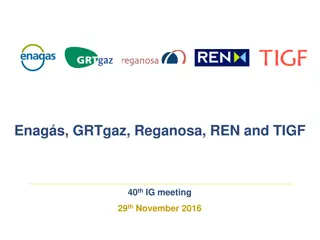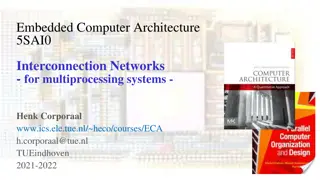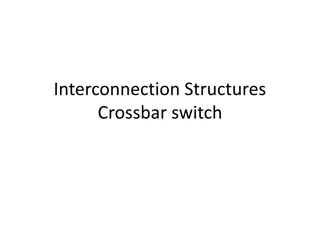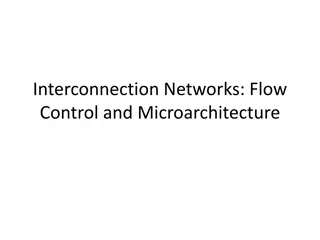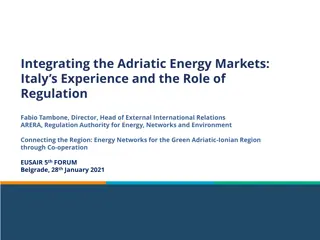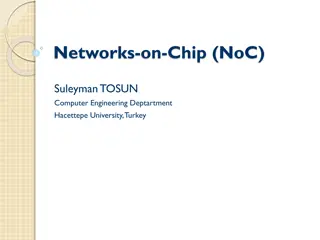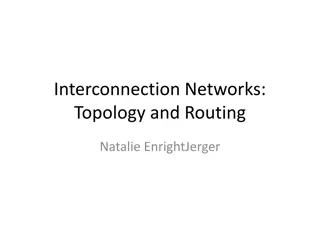Safety First and Always: DG Interconnection Seminar Process
Learn how to ensure safety while connecting Distributed Energy Resources. Understand the simplified process for interconnection, including key steps and safety precautions. Join us to enhance your knowledge and protect yourself and your team.
0 views • 26 slides
Computational Physics (Lecture 18)
Neural networks explained with the example of feedforward vs. recurrent networks. Feedforward networks propagate data, while recurrent models allow loops for cascade effects. Recurrent networks are less influential but closer to the brain's function. Introduction to handwritten digit classification
0 views • 55 slides
Evolution and Potential of 5G Technology
Explore the evolving landscape of 5G technology, from enhanced mobile broadband to groundbreaking use cases and standalone networks. Learn how supportive regulations and spectrum allocation are vital for unlocking 5G's full potential. Discover the transformative impact of Standalone 5G networks on i
8 views • 10 slides
Understanding Computer Networks: Types and Characteristics
In the realm of computer networks, nodes share resources through digital telecommunications networks. These networks enable lightning-fast data exchange and boast attributes like speed, accuracy, diligence, versatility, and vast storage capabilities. Additionally, various types of networks exist tod
9 views • 12 slides
Graph Neural Networks
Graph Neural Networks (GNNs) are a versatile form of neural networks that encompass various network architectures like NNs, CNNs, and RNNs, as well as unsupervised learning models such as RBM and DBNs. They find applications in diverse fields such as object detection, machine translation, and drug d
2 views • 48 slides
Federal Energy Regulatory Commission Transmission Update - Nov. 3, 2023
FERC, led by Director Rob Thormeyer, regulates natural gas wholesale facilities, interstate pipelines, onshore LNG facilities, wholesale electric market rates, and more. The Commission consists of five appointed Commissioners overseeing key initiatives like transmission planning proposals and interc
0 views • 14 slides
Improvements to Generator Interconnection Procedures: ISO New England Response
FERC's Notice of Proposed Rulemaking seeks to enhance generator interconnection procedures to address queue backlogs and promote fairness. ISO New England outlines expansive changes, including a first-ready, first-served process, and discusses trade-offs in project viability and completion expectati
0 views • 36 slides
Understanding Artificial Neural Networks From Scratch
Learn how to build artificial neural networks from scratch, focusing on multi-level feedforward networks like multi-level perceptrons. Discover how neural networks function, including training large networks in parallel and distributed systems, and grasp concepts such as learning non-linear function
1 views • 33 slides
Understanding Back-Propagation Algorithm in Neural Networks
Artificial Neural Networks aim to mimic brain processing. Back-propagation is a key method to train these networks, optimizing weights to minimize loss. Multi-layer networks enable learning complex patterns by creating internal representations. Historical background traces the development from early
1 views • 24 slides
Proposed Enhancements for Generator Interconnection Process
Enhancements proposed for the generator interconnection process include creating a distinction between large and small generators, establishing tracking processes for small generators, and modifying existing sub-sections to incorporate small and large generators in Sections 5 and 6. The goal is to s
1 views • 12 slides
Large Load Interconnection and Modification Guidelines
Ensure new or modified large loads are interconnected in a manner that maintains system reliability and complies with relevant standards and protocols. General provisions, interconnection agreements, procedures, and study processes are outlined to facilitate smooth integration within the ERCOT syste
0 views • 22 slides
Understanding Interconnection Networks in Multiprocessor Systems
Interconnection networks are essential in multiprocessor systems, linking processing elements, memory modules, and I/O units. They enable data exchange between processors and memory units, determining system performance. Fully connected interconnection networks offer high reliability but require ext
1 views • 19 slides
Interconnection Discussion Forum Timeline Review - 01/16/18
Interconnection Discussion Forum held on 01/16/18 discussed safety measures, meeting objectives, and timeline objectives. The agenda covered topics like submitting applications, engineering reviews, design, construction, and commissioning. Safety protocols for emergencies like earthquake and evacuat
0 views • 14 slides
Discover Rwanda: African Peering and Interconnection Forum 2020
Rwanda, the host of the African Peering and Interconnection Forum 2020, offers a remarkable blend of stunning scenery, friendly people, and economic development. With a focus on internet and ICT, the country boasts 4G LTE coverage, a growing MICE industry, investment opportunities, and accessibility
1 views • 8 slides
Evolution of MISO Interconnection Process: Enhancing Certainty and Efficiency
The MISO Interconnection Process has evolved over the years, reflecting improved certainty and efficiency. From historical trends to current statistics, the process highlights challenges, adjustments, and next steps to address issues like project dropouts, uncertainty in timing and costs, and entry
0 views • 11 slides
DGR Interconnection Conditions Overview
Interconnection requirements for Distributed Generation Resources (DGR) include coordination with Distribution Service Providers (DSP), confirmation of operational limitations, and compliance with ERCOT regulations. These conditions ensure safe and efficient integration of DGRs into the electrical g
0 views • 19 slides
Interconnection Discussion Forum Projects Update
Update on interconnection activities, projects over 1MW, and themes discussed in the forum. Includes meeting objectives, agenda topics, inquiry themes, and PG&E interconnection updates on process changes and completed/planned actions.
0 views • 15 slides
Updates on Generator Interconnection Procedures and Agreements Reform
ISO-NE is implementing further compliance reforms in response to FERC Order No. 845 regarding Generator Interconnection Procedures and Agreements. This includes proposed tariff language updates and discussions on surplus interconnection services. The changes aim to enhance the efficiency and effecti
0 views • 14 slides
Introduction to Neural Networks in IBM SPSS Modeler 14.2
This presentation provides an introduction to neural networks in IBM SPSS Modeler 14.2. It covers the concepts of directed data mining using neural networks, the structure of neural networks, terms associated with neural networks, and the process of inputs and outputs in neural network models. The d
0 views • 18 slides
Interconnection Regulation vs. Deregulation Challenges in an Emerging Liberalized Market
Interconnection between telecommunication networks and services plays a vital role in enhancing value for subscribers and facilitating the provision of a wide range of services. Regulation of interconnection is essential to protect competition, achieve social objectives, manage scarce resources, ens
0 views • 22 slides
Global Energy Interconnection and Power Grid Interconnections
Global Energy Interconnection (GEI) envisions globally interconnected power grids supporting clean, renewable energy transmission worldwide. Ultra-high voltage technology enables efficient long-distance power transmission. The concept originated in the 20th century and was endorsed by the United Nat
1 views • 40 slides
Understanding Routing in Interconnection Networks
Routing in interconnection networks involves distributing traffic evenly among paths to avoid hotspots and contention, aiming for balanced throughput. Various routing algorithms, such as greedy, uniform random, and adaptive, are discussed with examples highlighting their impact on network performanc
2 views • 38 slides
Understanding Interconnection Networks Topology
Exploring the topology of interconnection networks helps determine the arrangement of channels and nodes, impacting network cost, performance, latency, energy consumption, and complexity of implementation. Abstract metrics such as degree, hop count, and network diameter play crucial roles in evaluat
1 views • 56 slides
P-Rank: A Comprehensive Structural Similarity Measure over Information Networks
Analyzing the concept of structural similarity within Information Networks (INs), the study introduces P-Rank as a more advanced alternative to SimRank. By addressing the limitations of SimRank and offering a more efficient computational approach, P-Rank aims to provide a comprehensive measure of si
0 views • 17 slides
Understanding Rules 2, 15, 16, and 21 in Utility Interconnection
This draft provides an overview of rules governing utility interconnection, focusing on Rules 2, 15, 16, and 21. It outlines meeting and learning objectives related to policy questions, mitigation costs, and interconnection timelines. Definitions of Line Extension (Rule 15) and Service Extension (Ru
0 views • 46 slides
Understanding Overlay Networks and Distributed Hash Tables
Overlay networks are logical networks built on top of lower-layer networks, allowing for efficient data lookup and reliable communication. They come in unstructured and structured forms, with examples like Gnutella and BitTorrent. Distributed Hash Tables (DHTs) are used in real-world applications li
0 views • 45 slides
Understanding Networks: An Introduction to the World of Connections
Networks define the structure of interactions between agents, portraying relationships as ties or links. Various examples such as the 9/11 terrorists network, international trade network, biological networks, and historical marriage alliances in Florence illustrate the power dynamics within differen
0 views • 46 slides
Understanding Network Analysis: Whole Networks vs. Ego Networks
Explore the differences between Whole Networks and Ego Networks in social network analysis. Whole Networks provide comprehensive information about all nodes and links, enabling the computation of network-level statistics. On the other hand, Ego Networks focus on a sample of nodes, limiting the abili
0 views • 31 slides
Gas Interconnection Agreements and Balancing Implementation Insights
Gas industry stakeholders Enags, GRTgaz, Reganosa, REN, and TIGF collaborated on various public consultations and discussed the implementation of Balancing Network Codes. Key topics include interconnection agreements, exceptional event situations, local products for balancing services, and the publi
0 views • 13 slides
Evolution of Networking: Embracing Software-Defined Networks
Embrace the future of networking by transitioning to Software-Defined Networks (SDN), overcoming drawbacks of current paradigms. Explore SDN's motivation, OpenFlow API, challenges, and use-cases. Compare the complexities of today's distributed, error-prone networks with the simplicity and efficiency
0 views • 36 slides
Interconnection Networks in Multiprocessing Systems Overview
Explore the intricacies of interconnection networks for multiprocessing systems in Embedded Computer Architecture, covering connecting processors, topologies, routing, deadlock, switching, and performance metrics like bandwidth and latency. Delve into various network types, such as on-chip networks
0 views • 33 slides
Understanding Crossbar Switch Interconnection Structures
Interconnection structures like crossbar switches consist of crosspoints that control the pathways between processors and memory modules. The switch determines the transfer path and resolves access requests on a priority basis. Through multiplexers and arbitration logic, crossbar switches enable sim
0 views • 6 slides
Understanding Interconnection Networks, Flow Control, and Microarchitecture
Interconnection networks play a crucial role in determining the flow control and routing paths within a network, impacting throughput and latency. Different switching techniques like circuit-switching, packet-based, and flit-based control the allocation of resources at various granularities. Circuit
0 views • 41 slides
Integrating Adriatic Energy Markets: Italy's Regulatory Perspective
The presentation delves into Italy's experience in integrating Adriatic energy markets and the crucial role of regulation by ARERA. Exploring the promotion of markets integration, the talk highlights regulatory convergence in practice through projects like the MONITA interconnection. Italy's Regulat
0 views • 17 slides
Understanding Networks-on-Chip (NoC) in Computer Engineering
Networks-on-Chip (NoC) represent a packet-switched communication network designed for on-chip systems, allowing efficient data routing via switches and interconnection links. NoCs aim to apply large-scale network concepts in embedded systems, offering scalability, flexible QoS guarantees, higher ban
0 views • 29 slides
Understanding Interconnection Networks: Topology and Routing
Interconnection networks play a crucial role in determining the arrangement of channels and nodes within a network, similar to a road map guiding traffic flow. Topology overview defines the network structure, while abstract metrics help evaluate performance and cost. Latency and throughput are key f
0 views • 49 slides
Comparison of Generator Governor Dead-band Settings in ERCOT Interconnection
This report compares the generator governor dead-band settings in the ERCOT Interconnection for the years 2008 and 2015 from January to November. It outlines the changes in the dead-band settings over the years, including the requirements for proportional response, improvements in primary frequency
0 views • 17 slides
Understanding Interconnection Networks in Embedded Computer Architecture
Explore the intricacies of interconnection networks in embedded computer architecture, covering topics such as connecting multiple processors, topologies, routing, deadlock, switching, and performance considerations. Learn about parallel computer systems, cache interconnections, network-on-chip, sha
0 views • 43 slides
Understanding Deep Generative Bayesian Networks in Machine Learning
Exploring the differences between Neural Networks and Bayesian Neural Networks, the advantages of the latter including robustness and adaptation capabilities, the Bayesian theory behind these networks, and insights into the comparison with regular neural network theory. Dive into the complexities, u
0 views • 22 slides
Enhancing Western Interconnection Congestion Management
Addressing congestion management challenges within the Western Interconnection through the Western Interconnection Unscheduled Flow Mitigation Plan (WIUFMP). The plan focuses on curtailing tagged energy transfers during critical events and optimizing generation-to-load impact calculations, aiming to
0 views • 23 slides
